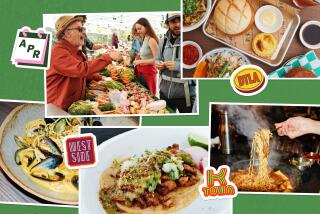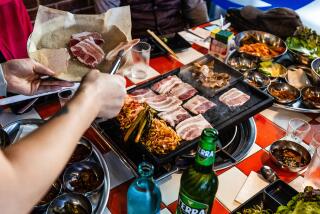That salad sounds healthful, but is it?
It’s lunch time, and the lasagna on the menu is tempting. But you’re trying to cut down on fat, so you go with the chicken Caesar salad instead.
After all, after years of warnings about cholesterol and salt and fat content, you probably think you know a thing or two about healthful choices.
But it turns out that what Californians “know” about the nutritional value of the food they order in chain restaurants may be the stuff of mythology.
When more than 500 Californians were shown lists of four dishes served at chain restaurants and asked to identify the one with the most fat or the least salt or the fewest or most calories, 68% of them chose the wrong item every time.
Just 27% got only one of the multiple-choice questions right. And not one of the 523 Californians who were surveyed aced the test.
The four-question quiz -- which focused on food served at Denny’s, Chili’s, McDonald’s and Romano’s Macaroni Grill -- was commissioned by the California Center for Public Health Advocacy, a nonprofit group based in Davis, and conducted by Field Research Corp. The findings were the same, regardless of education or income levels.
Even the center’s executive director, Harold Goldstein, flunked the test, despite holding a doctorate in public health.
“More and more fast-food restaurants are claiming that they are providing healthy choices, and commonly the choice will have a word like ‘salad’ in it,” Goldstein said. “But you could be blindfolded throwing a dart at the menu board, and you’ve got a better chance at making the healthy choice.”
The findings do not bode well for a state in the middle of an obesity epidemic, said Alecia Sanchez, a Sacramento-based spokeswoman for the American Cancer Society. More than half of California adults are overweight or obese and at risk of diabetes, heart disease and high blood pressure. One in three cancer deaths is related to poor diet, inactivity or obesity, Sanchez said.
Goldstein’s center is using the survey results to lobby for a bill, introduced by state Sen. Alex Padilla (D-Pacoima) that would require chain restaurants in California to include nutritional information on their menus, much as the U.S. Food and Drug Administration requires nutritional labeling for food sold in grocery stores.
The center’s survey found that 84% of those polled supported such a law.
“The reality is that people are eating out,” said Sanchez, adding that nearly half of all food dollars are spent at restaurants. “So we need to give them the tools to be able to do that.”
While stopping short of saying that people would be better off not eating out so much, Goldstein said that forcing fast-food restaurants to publicize nutritional information could have an added benefit.
“I think it is quite likely to pressure chains to make some changes in their product so that they won’t have to say that one chocolate shake has 1,160 calories,” he said.
The measure is opposed by the California Restaurant Assn. as impractical and overly expensive. Many restaurants already make the information available on their websites or in pamphlets, and offer customers a wide variety of food and portion sizes, said spokeswoman Kearsten Shepherd.
Besides, Shepherd said, even though spending on restaurant meals has gone up, a majority of meals still are prepared at home, and labeling on grocery items hasn’t prevented the obesity crisis.
“It’s about dietary habits, individual choice, education,” she said.
Walt Riker, vice president for McDonald’s Corporate Media Relations, said in an e-mail that the chain provides customers with nutritional information on the Web, in-store brochures, tray liners and packaging.
“An objective review of our actions, and the reality inside our restaurants, will clearly show that McDonald’s is providing more choice and variety than ever before, that we are providing more information to consumers than probably anyone else,” he said.
Goldstein countered that tray liners provide nutritional information for food items only after the customer has ordered. “I’m not sure what the industry expects,” he said. “That we’ll take our laptop to the restaurant?”
And what about that chicken Caesar salad? If you were dining at a Romano’s Macaroni Grill and abandoned the lasagna in hopes of cutting back on fat, you’d be making a mistake.
The chain’s website says that the chicken Caesar salad has 69 grams of fat, while the traditional lasagna has 54 grams.
The American Heart Assn. recommends limiting fat to no more than 30% of daily calories, about 73 grams a day or 53 grams a day for sedentary women and the elderly.
*
*
(BEGIN TEXT OF INFOBOX)
Test your nutrition IQ
A new Field Research Corp. poll asked Californians to identify the low calorie, low salt, high fat or high calorie menu items from a list of four choices. Of the people surveyed, 68% failed every question. Think you can do better?
1. Which of the following breakfast items that are served at Denny’s do you think has the fewest calories?
A. Ham and cheddar omelet
B. Country-fried steak and eggs
C. 3 slices of French toast with syrup and margarine
D. 3 pancakes with syrup and margarine
2. Which of the following items that are served at Chili’s do you think has the least salt?
A. Cajun chicken sandwich
B. Classic combo steak and chicken fajitas
C. Guiltless chicken platter
D. Smoked turkey sandwich
3. Which of the following items that are served at Romano’s Macaroni Grill do you think has the most fat?
A. Traditional lasagna
B. Chicken Caesar salad
C. Pasta classico with sausage and peppers
D. BBQ chicken pizza
4. Which of the following items that are served at McDonald’s do you think has the most calories?
A. 2 Big Macs
B. 2 Egg McMuffins
C. 1 large chocolate shake
D. 4 regular hamburgers
Answer Key
1. (B) Country fried steak and eggs (464 calories); 2. (A) Cajun chicken sandwich (2,220 mg sodium); 3. (B) Chicken Caesar salad (69 g fat); 4. (C) 1 large chocolate shake (1,160 calories)
Source: California Center for Public Health Advocacy
More to Read
Eat your way across L.A.
Get our weekly Tasting Notes newsletter for reviews, news and more.
You may occasionally receive promotional content from the Los Angeles Times.






